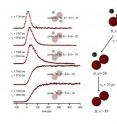A simple quantum dynamics problem?
Research reported in The Journal of Chemical Physics, which is published by the American Institute of Physics, provides the first real-time measurements of the time dependence of the individual steps of dissociation of a complex consisting of two rare gas atoms and a halogen molecule. "The goal of this work is to provide a test case for quantum dynamics theory," says author Kenneth C. Janda of the University of California, Irvine. "It is a problem that is easy, but not too easy, in the sense that a fundamental quantum dynamics explanation is within reach."
Researchers cooled a mixture of helium, neon, and bromine by spraying it through a nozzle, resulting in a stream of gas particles traveling at the same speed. This created a very low temperature in a moving frame of reference -- the particles were stationary relative to one another and condensed to form Ne(2)Br(2) tetrahedral complexes. After the bromine molecule was excited with a laser pulse, the dissociation of the complex over a period of tens of picoseconds was observed spectroscopically. Adding 16 quanta of vibrational energy to the bromine-stretching vibration resulted in rapid direct dissociation. The two Ne atoms dissociated without interacting with each other. However, with slightly higher vibrational excitation, a 23-quanta boost, the bromine anharmonicity led to sharing of the kinetic energy between the Ne atoms and a much more complicated dissociation mechanism.
"For 23 quanta, the first transfer of vibration fails to knock off one of the neon atoms 80 percent of the time," says Janda. "Instead a tiny liquid drop is formed, allowing a neon atom to move in a direct line with the bromine atoms. The next vibration shoots it off like a pool stick hitting the cue ball."
Source: American Institute of Physics
Other sources
- A simple quantum dynamics problem?from Science DailyThu, 15 Jul 2010, 6:21:28 UTC
- A simple quantum dynamics problem?from PhysorgWed, 14 Jul 2010, 13:28:10 UTC
- A simple quantum dynamics problem?from Science BlogWed, 14 Jul 2010, 13:21:23 UTC
- A Simple Quantum Dynamics Problem?from Newswise - ScinewsTue, 13 Jul 2010, 21:42:14 UTC
